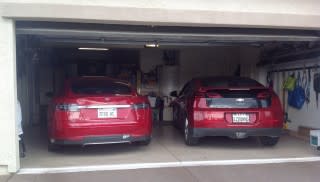California leads US in electric-car use, planning: here's what others can learn
Electric-car leadership isn't only about getting the vehicles on the roads.
Charging infrastructure, tax incentives, and a passionate fan base for cars that plug in are all important to build a community of electric-vehicle drivers who will spread the word.
With two decades of experience, California has a lot of knowledge—and some best practices it can teach other states. (If, that is, they're willing to listen.)
A Bloomberg editorial on what the state can teach other localities, for example, cites a new city law in San Francisco taking effect this year that requires at least 10 percent of parking spaces in new buildings to have wiring installed for future plug-in car charging stations.

Back in 2013, Palo Alto changed its building code to require something similar. Thanks to one strong-willed EV advocate in the city, it's easier to install curbside parking on city land.
And, of course, California offers some of the biggest financial incentives in the country for people to buy plug-in vehicles.
Most valuable may be single-occupancy use of the carpool lanes on the state's notoriously congested freeways.
The state's purchase rebates—not tax credits that can only be realized later on—are $2,500 for battery-electrics and $1,500 for qualifying plug-in hybrids, and they only lead a wide array of city and company benefits.
(It's probably worth noting here that Tesla was founded in Silicon Valley and is now California's sole carmaker, with every Tesla electric car now built at a former Toyota-GM assembly plant in Fremont.)
A few other states that want to encourage EV adoption have glommed on to California's ZEV mandate, which requires automakers to sell a certain number of electric vehicles in those states if they want to sell cars there at all.

But the list of ways that Michigan or Florida, say, could learn from California how to increase the number of EVs on their roads is long.
Step one is finding a reason: With six of the ten most polluted cities in the U.S., California has an obvious impetus to clean its air—and has had since the Conquistadors complained centuries ago about foul air in what's now the Los Angeles Basin.
Electric vehicles are one way the state has decided to tackle this problem. Once other states reach the same conclusion, they know where to turn.
Even in California, though, all of these efforts only scratch the surface of expected future demand.
Just looking at the infrastructure side of things, a study by UCLA and UC-Berkeley issued in summer 2017 found that, "Ultimately, some analysts estimate that the state will need private and public sources to provide 125,000 to 220,000 publicly accessible charging ports by 2020.
That's far above the roughly 12,000 available in the state today.

Additionally, hundreds of thousands of other charging stations will be necessary at multi-unit dwellings, the report noted.
The study goes on to offer a number of suggestions for how to get more multi-unit dwellings to add charging, more DC fast chargers, and how to reduce the cost of charging.
Perhaps California can learn something from itself, too.
_______________________________________

 Yahoo Autos
Yahoo Autos 
